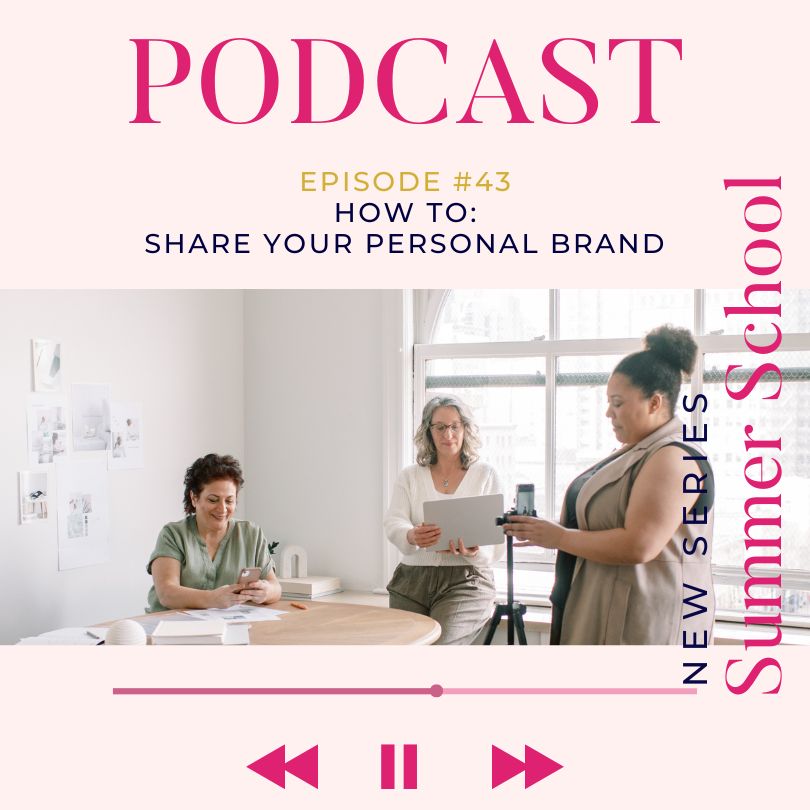
I’m excited to be joining you again today for our Summer School series, inspired by our sister company, Heirloom Leadership & Learning Co!
Over the last two weeks, we’ve been diving into how to build a personal brand.
This week is all about the entrepreneurs out there trying to figure out how to make their business stand out!
We’ll be going deeper on how to build a powerful business brand – and how to use your own personal brand to help elevate your business!
We’ll be working through how to really understand your audience and how to communicate the value of the products or services you offer.
Before we jump in, I want to remind you that you can download our completely free Personal Branding Roadmap at sheisfiercehq.com/brand
If you haven’t done so already, go grab that now!
It will help you build a personal brand and also gives you some tools you will use for your business brand.
You might know by now, but branding is one of my favorite things to speak about and teach – on stages, in Heirloom workshops and in our She Is Fierce! Memberships.
I love it because I have seen over and over again the incredible results my clients and our members have gotten when they did real, intentional work on their brands – and followed our branding roadmap to steps to success.
A lot of business owners, especially small businesses, struggle with branding and sales more than product or service, more than the back-end business stuff and more.
Honestly, a lot of huge businesses and wealthy business owners too – think Elon Musk here – but also the many big, well-funded businesses you see on the side of the road or online who provide a product or service you might actually like and *could* buy, but have never even considered buying from them – from sandwich shops to workout studios to software companies.
When we talked personal branding, I broke things down into eight steps over two episodes.
Since we’re doing this all in one episode, I’m going to give you a new list – some of the items will sound very similar to personal branding, and some require a little more research and well, business-minded work… but don’t worry, we’ll get there together!
So, here’s the breakdown of the steps we’re going to cover today:
- Identify your ideal client
- Research the marketplace
- Clarify your brand values and brand signature
- Choose how you will present your business brand through language
- Decide what your visual style will be
So, let’s dive in.
#1 – Identify your ideal client
Ok – so many people I work with start with their product or service in mind first – or their desire to give back by sharing their product or service.
Those two things are incredibly important, but right now – at the very beginning of your branding journey, they are only factors in your research, so try to start this journey with the mindset that you are seeking the people who will benefit the most from your product or service, actually WANT your product or service and can actually PAY for your product or service.
Now, this might sound obvious but I would say well over 50% of the new business owners or struggling business owners I talk to are stuck on number one – they may have even moved on and done a lot more of the branding work we’ll talk about next, but they are having a hard time because they are missing the critical foundation of a strong brand – understanding who are you selling to – and who you are communicating with.
So, before you start looking at your competitors or creating a logo or slogan, really consider who is out there in the world will benefit the most from your product or service, actually WANT your product or service and can actually PAY for your product or service… these are your people.
You may feel like you want your brand to be popular and well-known so you should try to get everyone to like it – this is a HUGE and very common mistake. The more clear your message is, the more likely your audience is to actually engage with and purchase from you… and in order to make your message hyper-clear, you need to get to know the people who are most likely to buy your product.
Find those people – and remember, this isn’t always the person who could benefit the most… a lot of mission-driven businesses struggle because we want to help everyone who could possibly benefit from what we do. That is a recipe for either a successful nonprofit or a business with no cash in the bank and a lot of people using your product or service who aren’t satisfied because you aren’t able to maintain the level of service required – because you can’t afford it.
I am certain of one thing – you do not want that mess.
And if you are running a nonprofit – amazing! – but honestly, most of these rules apply to nonprofits too.
#2 – Research the marketplace
Ok, there is a LOT out there on the internet about how to build a competitor analysis, so I’m going to refer you to Google if you’re looking to build a formal market analysis to share with investors.
But, even if you don’t need a formal 12 – 30 page document, you still need to do some research on what other businesses are out there doing what you’re doing and/or reaching the people you want to reach – your ideal clients.
There is SO much value in this exercise. You’ll want to take note of the products or packages they’re selling, the price points they’re selling at, where they’re advertising, what language they are using to communicate with their customers and if they are successful or not.
You’ll also want to identify what is different and special about your business that sets you apart from the crowd – you’ll do that in our next step.
Here’s the deal – a lot of this can be done online now. But don’t just doomscroll online at night wondering how you’ll ever be as good as a competitor or spend time thinking about how you’re already way ahead of the competition because you have x, y or z that they don’t have.
That is ALL a waste of your time.
Set time aside and take notes. Write all of your observations down and look at multiple competitors together once you have done all your research.
What are the similarities? What are the differences? Which businesses are more successful (that you know of?) and why?
What is the scale of pricepoints? For those who are able to charge more, what are they offering that makes them more valuable?
All of this will help you not only build a stronger brand but also make more sales when you start really pitching customers. Understanding the marketplace will give you a head start.
#3 – Clarify your brand values and brand signature
Ok, I go into a deep dive on brand values and brand signature in podcast #42, so I am going to encourage you to go back and listen to that one for a full overview of what this means… but at it’s heart, this is the exercise of figuring out what the values are that your brand stands for, and identifying your unique selling proposition, the thing your business does or provides that sets you apart from any competition.
Your values can align with your personal values, but make sure you are also considering the values of your ideal client. You may have family as a core value for example, but if you’re selling workout packages or handmade jewelry, that value is probably not as relevant. In those cases, you want to consider what values your ideal client holds- that your business can lean into – that relate to your product.
So, with the example of a handmade jewelry business, maybe a value your business holds is quality craftsmanship. That’s not likely to come up on your personal values list, but can be a powerful brand message if it aligns with your approach to business.
#4 – Choose how you will present your business brand through language
Ok, all that research you did on your ideal client is going to come in handy for the next two steps in our business branding exercise.
First, you’re going to clarify the kinds of words and the way you will speak with your prospective customers – are you going to be formal, informal, super casual and up front?
Will you use curse words to make an impact or will you keep your language very elegant and refined?
When making decisions about how you will communicate, always keep your ideal client in mind. How do they like to be spoken to? What brands do they connect with or find aspirational?
This is a great time to look at your market research – and you don’t necessarily want to speak to your ideal clients the way your direct competitors do. Instead, you may want to look at the brands they love in other spaces – for example, if you’re a life coach, you may want to think about how Lululemon approaches it’s audience if that is a brand that your prospective clients tend to purchase from… this isn’t always true (especially if you have a particularly high-end or low-end product), but it is a good starting point to really understand how your people like to connect.
You won’t be done with this exercise until you have:
- A brand positioning statement
- This is a simple statement about the value your products or services bring that rings true with your audience
- A slogan or tag line
- This is an even shorter and catchier version of your brand positioning statement that works well in advertising, on your website or on your business cards… think about the power of popular slogans like:
- America runs on Dunkin
- Red bull Gives You Wings
- Or everyone’s favorite… Just Do It.
- This is an even shorter and catchier version of your brand positioning statement that works well in advertising, on your website or on your business cards… think about the power of popular slogans like:
These are catchy, easy to remember phrases that either explicitly state or imply the values and brand signature of your business.
- And finally, you will want to put together a simple Brand Language Style Guide.
This can be a one or two sheet document that has your Brand positioning statement, your slogan, your offer overviews etc. – any wording you use consistently to promote your business.
In the future, you may add things like a generic press release that you edit each time you have a new thing to promote or a generic pitch email that you personalize before sending to a new prospective client.
Basically, we want to create a repository of all the best phrasing that gets you results – so you don’t have to re-write the same email, pitch or explanation of your offer every time there is a new opportunity.
Your work on your brand language style and its result – your final Brand Language Style Guide will make your life easier for years to come!
#5 – Decide what your visual style will be
First, if you are not a design-minded person, I highly recommend bringing in a professional for a little help with this one – and even if you are, you may want a designer to jump in and create a brand style guide with the basics all organized – and maybe with a few of their own designer flourishes.
Here are some of the items that should be on your checklist:
- Your logo… Do NOT, I repeat, do NOT do this yourself. If you only spend money on one design item, please let it be your logo!
- Your brand foundations…
- Decide on brand colors
- Remember to consider your Ideal Clients – what kinds of brands are they drawn to? Don’t copy a popular brand, but use their faves as inspiration for your own – maybe you have a swimwear brand. Without any more info, I might think your brand colors would be bright and colorful… but your product is actually high-end and your values are quality, refinement and luxury.
- In that case, your brand colors should probably not be bright and colorful, but instead a more subdued palette with hints of metallics might be your style.
- Design style, photo style that suits your products or services
- Think about if you want to be light and bright or sultry and moody… you will appeal to different clients and you’ll be communicating different brand values just by the colors and imagery you use – before anyone ever reads a line of your website.
- Decide on brand colors
At She Is Fierce!, I started with my own design mock-ups and our first couple websites were really my own work with a wonderful logo designer and a few tips and tricks I learned from listening to podcasts and reading up… but once I had a budget for design, I prioritized it and hired a fabulous graphic designer to take the pieces I already had, polish them and create a beautiful and useful brand guide with all of the different ‘rules’ for our visual brand and basics like color hex codes and logo placement.
With your logo, your brand style guidelines and imagery guidelines, you will have enough to create your brand assets like your website, brochures, business cards, email signatures etc.
OK – so at this point, you have followed five powerful steps:
- Identify your ideal client
- Research the marketplace
- Clarify your brand values and brand signature
- Choose how you will present your business brand through language
- Decide what your visual style will be
Ok, at this point, you will have a pretty clear and effective brand in place!
On future podcasts, I’ll take it to the next level with you on how to get your brand out there into the world through advertising, public relations and more – so make sure to subscribe to the podcast.
And if you haven’t already – please leave us a five star review and let me know what you want to learn more about – and who you want to hear from as a guest!
I’ll be back here next week with some lessons on overcoming challenges and even failures to come back stronger. I’m going to be sharing some of my own stories and some of the lessons I’ve learned from working with people who are really trying to figure out how to get out of a rut to those whose entire vibe screams success story… you’d be surprised about how much they have in common – and the simple things that set them apart.
If you haven’t done so already, go grab that completely free Personal Branding Roadmap at sheisfiercehq.com/brand and use it as your guide… or check out our Membership at sheisfiercehq.com/join to access our full Heirloom course on Building a Powerful Personal Brand which walks you through each of these steps in even more detail and includes a video with me going deeper and a step-by-step fill in the blank workbook… plus, inside our membership you have access to dozens of other workshops, Heirloom courses, mentor replays and more!
Or, if you’re still figuring out exactly what your next steps look like, you can grab out Free Passion & Purpose Challenge at sheisfiercehq.com/passion.
Podcast: Play in new window | Download




Be the first to comment